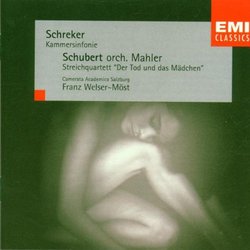| All Artists: Schubert, Schreker, Welser-Most Title: Death & The Maiden / Chamber Symphony Members Wishing: 0 Total Copies: 0 Label: EMI Classics Imports Original Release Date: 1/1/1998 Re-Release Date: 7/13/1999 Genre: Classical Styles: Chamber Music, Historical Periods, Classical (c.1770-1830), Modern, 20th, & 21st Century Number of Discs: 1 SwapaCD Credits: 1 UPC: 724355681324 |
Search - Schubert, Schreker, Welser-Most :: Death & The Maiden / Chamber Symphony
 | Schubert, Schreker, Welser-Most Death & The Maiden / Chamber Symphony Genre: Classical
|
Larger Image |
CD Details |
CD ReviewsAn intimate beauty Jdaniel1371 | Sacramento, CA United States | 11/17/2000 (5 out of 5 stars) "Schreker's "Chamber Symphony" (1916-17), with Welser-Most/CAS on EMI is another great early 20th-Century find. (Also try the Whitman Songs, on KOCH; and "Der Geburtstag der Infantin," on London.)Scored for eleven strings, harp, celesta, harmonium, piano, and percussion; the symphony's soundscape is similar to that of his opera, Die Gezeichneten: very ethereal, with wisps of nostaligic melody floating above bitonal harp/piano arpeggiation and shimmering strings. Schreker lends a wonderful sense of rhythm to the allegro passages, dispatching them with a buoyancy and lightness one typically associates only with the French.If Schoenberg's concern was to make *original* ideas sound *palatable* by retaining the forms of his predecessors, ("They call us modernists"--Schoenberg to Schreker), it occurs to me that Schreker's concern was to make *palatable* ideas sound *original* by downplaying form and embracing spontaneity. By doing so, Schreker, for better or for worse, helped set the stage for the "sound for its own sake" philosophies of composers from Varese to Ligeti.IMHO, what separates Schreker from some of the other neglected masters, (such as those on London's Entartete series), is his unerring sense of proportion, the eveness of quality within his works, and his original voice.If you were put off by the busy libretto and the seeming orchestral excesses of Gezeichneten, I highly recommend the Chamber Symphony as a stunning, yet small-scale example of Schreker's orchestral and compositional mastery.The recording is excellent and includes Mahler's orchestration of Schubert's "Death and the Maiden."" Interesting pairing, well-played Evan Wilson | Cambridge, Massachusetts United States | 11/15/2000 (5 out of 5 stars) "Pairing the early-20th century composer Franz Schreker with Franz Schubert might seem a bit odd, but in fact it works quite well because they both reflect the Viennese style of music-making.Gustav Mahler's "orchestration" of Schubert "Death and the Maiden" string quartet is very satisfying. While it inevitably loses some of the intimacy of a chamber piece, this version exposes the power and romantic depth of this music more effectively than any quartet could. Listen to the quiet coda to the slow movement to appreciate the benefits of added strings. Orchestration also reveals the kinship of Schubert and Dvorak. Listen to the scherzo here and one can hear a model for Dvorak's String Serenade. (If you like this, you'll love the Dvorak.)Schreker's Chamber Symphony is a neglected masterpiece. The opening will come as a bit of a shock right after the Schubert because Schreker dabbles in a bit of impressionism. The luminous texture of the opening, however, gives a hint of what is to come. This piece is full of wonderfully delicate, yet gorgeously rich orchestral textures. However, although the use of the orchestra stamps it as a 20th-century piece, Schreker harkens back to the sweet lyricism of Schubert with many beautiful melodies. This is music that soars because it isn't burdened with the heavy "philosophical" point-making that makes some some 20th-century Germanic music tough to listen to. (Which isn't to say that I avoid such music--I just like to feel seraphic occasionally!) Both pieces are played wonderfully by the Camerata Academica Salzburg under Welser-Most and the sound is rich. This is one of my favorite discs of the year."
|

 Track Listings (9) - Disc #1
Track Listings (9) - Disc #1